Last month Login VSI presented the results of their State of the VDI and SBC union world-wide survey. Together with the help of Ruben Spruijt (CTO Atlantis computing) and ControlUp they published a thorough 59-page document holding all kinds of interesting VDI and SBC related statistics. The survey was completed by 580 people in total. I went through the report and picked out a couple of subjects which are currently of most interest for me personally, for multiple reasons.
Download your copy of the full report here.
Desktop as a Service
The general interest for Desktop as a Service (DaaS) solutions has seem to have grown substantially. Over 40% of participants is investigating how DaaS can help them fulfil certain business requirements. This was all still prior to the new Microsoft CSP licensing model around Windows 10 (including virtualization rights), which was announced during Inspire, one of Microsoft’s yearly tech events – making life, again a little easier from a client as well as CSP perspective. Meaning (certified) CSP’s can now run and offer Windows 10 based DaaS solutions, on multi-tenant hardware configurations without the need for customers to bring in their own licenses, great!
Not surprisingly, Citrix came out on top as the preferred DaaS technology. This includes Citrix installed on Azure, which leans more towards IaaS, and CSP’s using Citrix technology for DaaS purposes. I’m sure the renewed collaboration between Citrix and Microsoft has had a big influence on all this. Not that long ago they introduced XenApp and XenDesktop Essentials, only available on Microsoft Azure – the first multi-tenant public cloud platform to host and offer Windows 10 based virtual machines.
Both XenApp and XenDesktop running on ‘plain’ Azure, with the control plane being hosted in the Citrix Cloud (which has also been completely moved to Azure) have gotten a lot of attention from the development teams as well. Adding to the stability and overall feature set.
Some of the main reasons for customers/businesses to consider DaaS include but are not limited to: stepping away from the capex model and moving towards opex, which is something I’m seeing on daily basis as well and is just limited to (virtual) desktop or application use, plus the ability to scale up and down more easily.
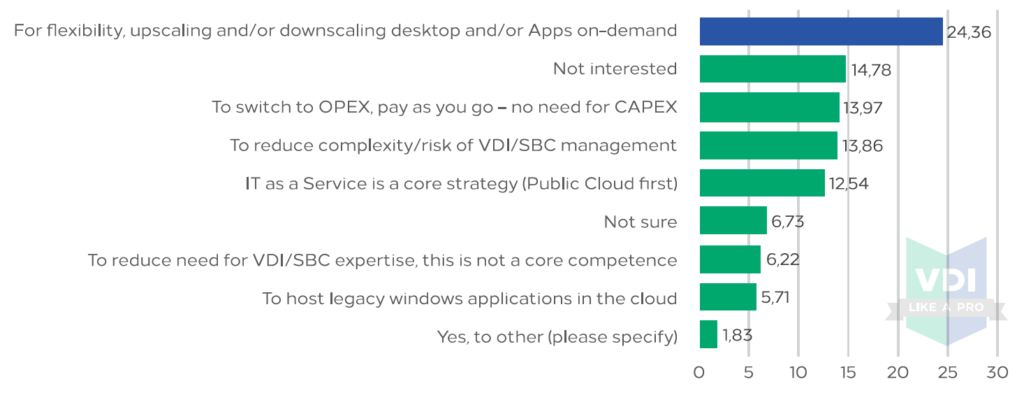 Also notice the statements: ‘To reduce complexity/risk of VDI/SBC management’ and ‘To reduce need for VDI/SBC expertise’, which, depending on your solution of choice might not always be the case – it’s not always as straightforward as one might expect or hope. But I guess this is something you’ll learn as you go. And of course, products and services do get better over time as well.
Also notice the statements: ‘To reduce complexity/risk of VDI/SBC management’ and ‘To reduce need for VDI/SBC expertise’, which, depending on your solution of choice might not always be the case – it’s not always as straightforward as one might expect or hope. But I guess this is something you’ll learn as you go. And of course, products and services do get better over time as well.
Patching
This has been a hot topic, lately and with good reasons. 50% of all correspondent state that they patch their systems once a month, while around 20% patch their systems multiple times per month. Over 24% stated that all patching is still done manually. Without proper context, I find this a hard number to comment on. While 24% seems like a relatively high number, especially with all the options around automation we have today, it could be down to very a small environment, low budgets or other reasons that might make good sense, so I’ll leave this alone for now. Hopefully, within a couple of years from now the 50/20 statements that I started out with will be the other way around.
Multiple of our customers, contiguously monitor, and patch (when needed) their systems on ongoing and daily basis. This goes for mobile as well as desktop, laptop and server systems. Of course, both approaches have their own pros and cons, but I can tell you, these were the customers that were not, or least affected by what has been happening throughout the last couple of months.
EMM
There was only one direct question around Enterprise Mobility Management. While the survey is primarily aimed at VDI and SBC environments, the integration of mobile devices, especially when it comes to accessing/reading/storing company related data is huge. And yes, I know that: 6.27% mobile devices, is the answer to the question: What is the ratio of devices being used to access VDI/SBC? See below. But I’m sure that most are referring to full (virtual) desktops here, which makes sense – iPads are made for swiping, intermitted and lap use only, not to operate virtual desktops.
And by the way, laptops came out on top with 29,74% as an answer to the same question. I think we all agree that laptops are mobile, right. Though of course, it all depends on your definition of ‘mobile’.
Note the huge amount of physical (Windows based) desktops, workstations and laptops (almost 60%) being used to access VDI and SBC environments. A huge market potential for devices like the Citrix HDX ready Pi and Google Chromebook, to name a few. Especially now that they have come out with a new receiver.
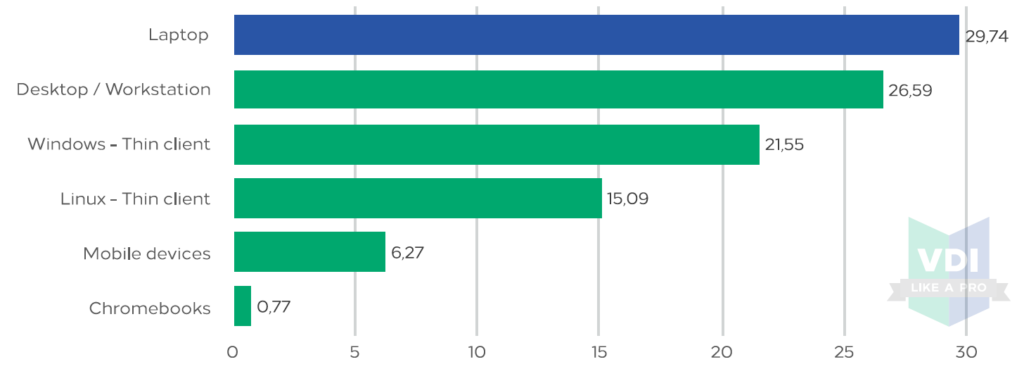 Anyway, the way mobile devices, in the broadest sense of the word are (contiguously) monitored, patched and maintained, plus the separation of personal and business related data are probably a couple of the biggest challenges companies are dealing with today. Never mind if they are company owned, BYOD etc. Oh, and I almost forgot to mention that Microsoft is winning terrain on these grounds, quickly. Here they’ve also teamed up with Citrix. Besides that, it just seems that everything Microsoft introduces or launches these days turns out to be successful.
Anyway, the way mobile devices, in the broadest sense of the word are (contiguously) monitored, patched and maintained, plus the separation of personal and business related data are probably a couple of the biggest challenges companies are dealing with today. Never mind if they are company owned, BYOD etc. Oh, and I almost forgot to mention that Microsoft is winning terrain on these grounds, quickly. Here they’ve also teamed up with Citrix. Besides that, it just seems that everything Microsoft introduces or launches these days turns out to be successful.
Windows applications, GPU’s, virtualization and layering
The use of Windows applications has grown! Yes, one of the main reasons why we will see hybride cloud infrastructures/solutions grow in the coming years, but I digress. Windows application are here to stay for a long time, and we will just have to deal with that. The report states that they believe historical challenges around Windows applications, like costs, complexity and performance have been solved by GPU and flash/SDS solutions, to name a few, I doubt that. At least as far as the use of GPU’s go.
If you look up the statistics around GPU use, adoption is slow. They are (too) expensive and properly configured VDI and SBC environments without a GPU function/perform just fine – are wat most are saying. I would agree. Adding a GPU boosts the overal UX, yes, but does that mean we need to include a GPU into every VDI/SBC environment that we design/built, no. It’s a tool in the toolbox, as many consultants say, use it where it makes sense. Also, if anything, adding a GPU to the equation only makes it more complex to setup and manage. It’s another ‘layer’ that needs attention, no matter how you look at it. Never the less there is a noticeable increase in deployments, NVIDIA mostly.
Virtualization
40% of the participants claim to not be using any form of application virtualization, at all. Also, of all the Windows applications deployed around 27% isn’t being virtualized, and only 4,47% state that all their Windows applications are being virtualized. As they mention in the survey as well, this could be because more Windows applications are moving to the web (SaaS), lesser conflict or the increasing use of VDI deployments.
The huge number of physical machines still being used might also have some influence on this – assuming we’re not just talking about VDI/SBC installations here. Application virtualization is great and can overcome multiple obstacles, on the other hand, it also adds to the complexity of an environment. On multiple occasions I have seen complete App-V teams being put together, to take care of business. A costly and time consuming undertaking.
Layering
What does surprise me though, is the lack of of application layering in most environments. With all that has been going on in this space I would have expected to see a higher percentage of companies using application layering technology in some shape or form. As it stands now, almost 75% doesn’t use application layering at all. It simply proves that adoption takes time – or that they don’t see the added benefits, which I doubt. Luckily, if you look at the question: What are your most important Workspace/EUC initiatives for 2017/2018? (Multiple choice) – the number five answer is ‘Layering technology’, so it is high up there.
I’m quite sure these numbers will look somewhat different two years for now. And while Unidesk has gotten a lot of attention when they became part of Citrix not that long ago, and App Volumes before that under the VMware flag, don’t rule out Liquidware Labs with their Flexapp solution. In fact, they are just about the only ones that can back it up with a complete suite of integrated products and services (ProfileUnity and Stratusphere).
Containers
Container technology is also catching on relatively slowly, which isn’t that surprising. It’s like they highlight in the report as well, most applications are not designed to run from within a container. Or better said, most container technologies/solutions mainly focus on various types of server/back-end applications like: web servers, mail servers, database server and so on, while with VDI/SBC most of what we deal with are desktop/user type applications.
Also, there are multiple serious players out there when it comes to container technology, while most of whom I talk to only know about Docker. It takes time to get your name known, especially now that Microsoft and Docker teamed up as well – their marketing machine (and reach) is huge, even though they might not always offer the best solution out there. It will take time, but change is coming.
Office (365)
It comes as no surprise that Office 365/2016 adoption has been huge over the past year (s). And although the use of Office365 offers tons of benefits to a lot of companies, there are still a few drawbacks as well. Your data resides in the Azure cloud, meaning you will have to traverse the big bad internet to ‘get there’. Even today, this apposes some challenges every now and again, especially when dealing with non-persistent (pooled) desktops, a popular deployment model, though you will encounter the same types of issues when working on SBC/RDS type environments as well. Here I am talking about things like poor performance and time-outs while opening emails or calenderer items, and slow response when searching your inbox or personal folders, for example. And I mean, real slow. While there are some workarounds available, they’re far from ideal.
Luckily, we have companies/solutions like Fslogix, and their Office 365 Containers, to name one helping us to get rid of these types of issues, enabling us to take full advantage of our VDI and/or SBC workloads in all shapes and forms.
Concluding
I really like the State of the VDI and SBC union survey, it provides some good, often surprising but always helpful insights. I hope they will continue to keep conducting the survey going forward – every other year would have my preference. Of course, there is lots I haven’t discussed, but I must stop somewhere, right? See the download link at the beginning of this post to have a look for yourself – you won’t be disappointed, trust me.


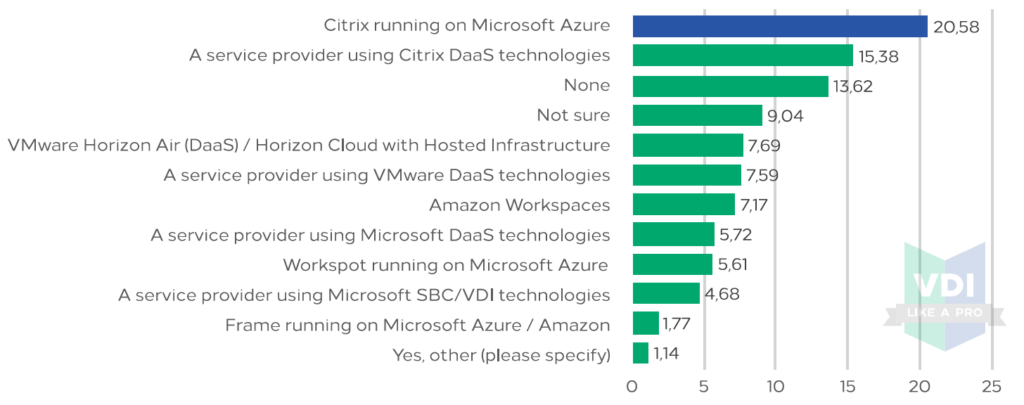

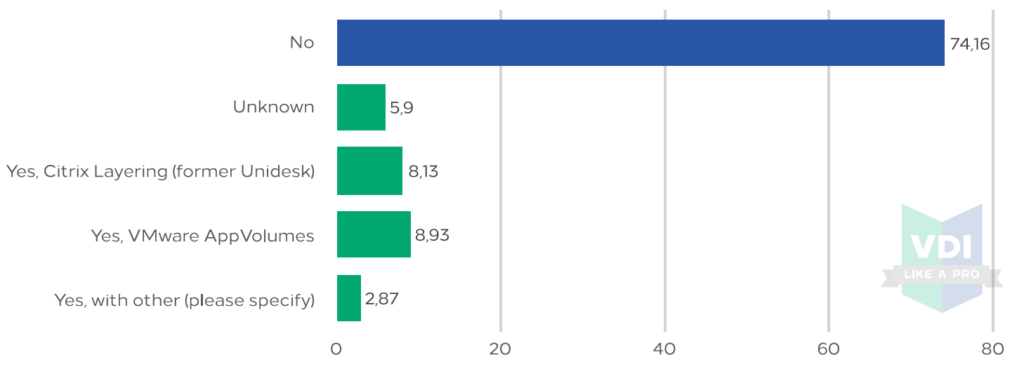
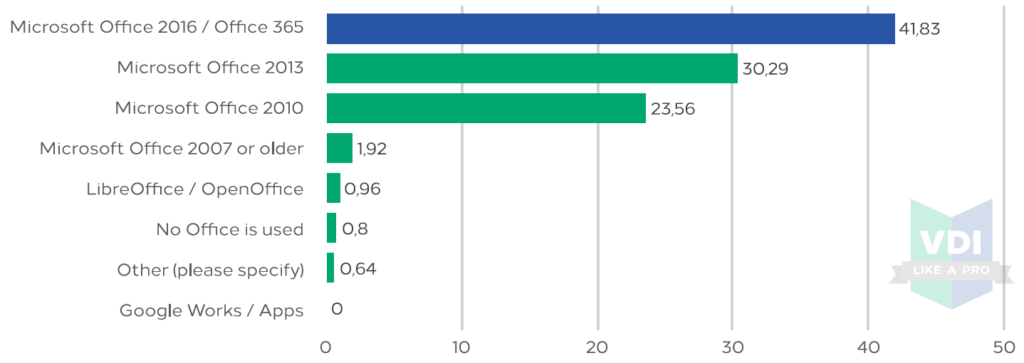







3 responses to “A few ‘State of the VDI and SBC union’ results in more detail”
No love for Workspot?
Not particularly, no. There are/were at least a dozen other companies, technologies I could have mentioned as well. Workspot is doing ok, don’t like their aggressive marketing strategy, though. They’re not the only ones taking a similar approach, I know.
[…] Read the entire article here, A few ‘State of the VDI and SBC union’ results in more detail […]